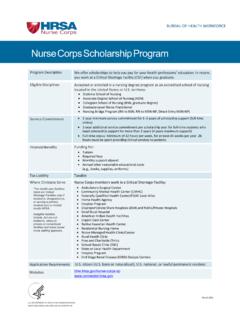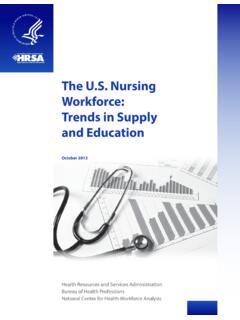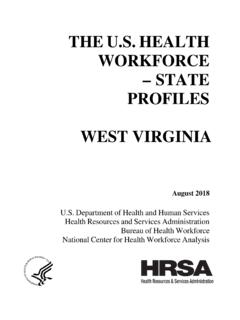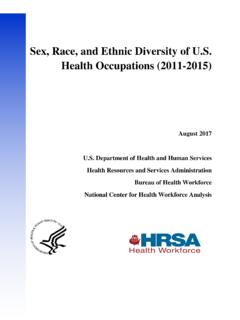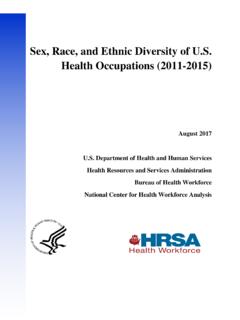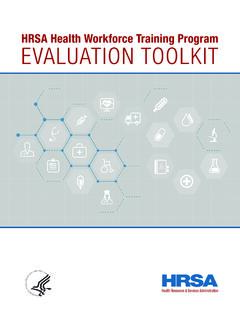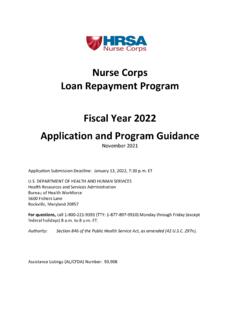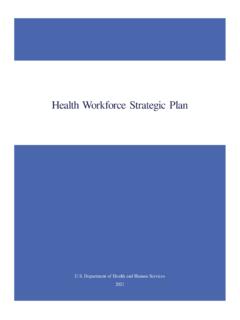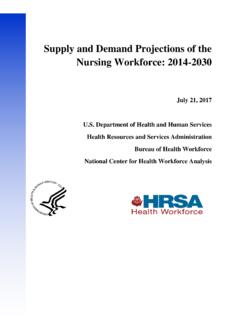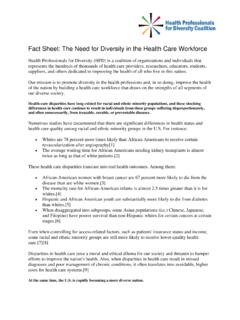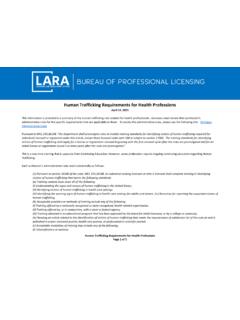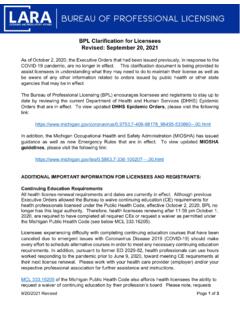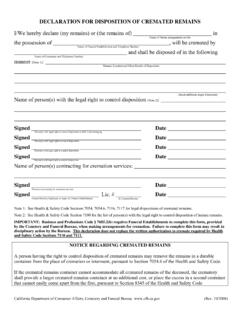Transcription of Behavioral Health 2013-2025 - Bureau of Health Workforce
1 National Projections of Supply and Demand for Selected Behavioral Health Practitioners: 2013-2025 November 2016 Department of Health and Human Services Health Resources and Services Administration Bureau of Health Workforce National Center for Health Workforce Analysis National Projections of Supply and Demand for Behavioral Health Practitioners: 2013-2025 1 About the National Center for Health Workforce Analysis The National Center for Health Workforce Analysis (the National Center) informs public and private-sector decision-making on the Health Workforce by expanding and improving Health Workforce data and its dissemination to the public, and by improving and updating projections of supply and demand for Health workers. For more information about the National Center, please visit our website at Suggested citation: Health Resources and Services Administration/National Center for Health Workforce Analysis; Substance Abuse and Mental Health Services Administration/Office of Policy, Planning, and Innovation.
2 2015. National Projections of Supply and Demand for Behavioral Health Practitioners: 2013-2025 . Rockville, Maryland. Copyright information: All material appearing in this documentation is in the public domain and may be reproduced or copied without permission. Citation of the source, however, is appreciated. National Projections of Supply and Demand for Selected Behavioral Health Practitioners: 2013-2025 National Projections of Supply and Demand for Behavioral Health Practitioners: 2013-2025 2 This brief presents national projections of supply and demand for Behavioral Health practitioners in 2025, with 2013 data serving as baseline. Projections were developed using the Health Resources and Services Administration s (HRSA) Health Workforce Simulation Model (HWSM). A total of nine types of Behavioral Health practitioners were considered in these estimates: psychiatrists; Behavioral Health nurse practitioners (NPs); Behavioral Health physician assistants (PAs); clinical, counseling, and school psychologists; substance abuse and Behavioral disorder counselors; mental Health and substance abuse social workers; mental Health counselors; school counselors; and marriage and family therapists.
3 These professions were chosen because they have the largest number of providers within Behavioral Health care. The HWSM is an integrated microsimulation model that estimates current and future supply and demand for Health care workers in multiple professions and care settings. Projections presented here represent a range based on two Workforce scenarios: a baseline scenario and an alternative scenario. Under the first scenario, the baseline demand for each Behavioral Health profession, with the exception of psychiatrists, was assumed to be in equilibrium with 2013 provider supply consistent with standard Workforce research methodology as there were no consistent data sources available to estimate shortages/surpluses by profession in 2013. For psychiatrists, however, baseline demand was assumed to exceed 2013 supply by the approximately 2,800 psychiatrists needed to de-designate the mental Health Professional Shortage Areas (HPSAs).
4 A detailed description of the HWSM can be found in the accompanying technical document available at 1 The second scenario uses findings from the Substance Abuse and Mental Health Services Administration s (SAMHSA) 2013 National Survey on Drug Use and Health32, to estimate 1 Department of Health and Human Services, Health Resources and Services Administration. 2014. Shortage Designation: Health Professional Shortage Areas and Medically Underserved Areas/Populations. Accessed 11/16/2015: 2 Department of Health and Human Services, Substance Abuse and Mental Health Services Administration. 2014. Results from the 2013 National Survey on Drug Use and Health : Mental Health Findings, NSDUH Series H-49, HHS Publication No. (SMA) 14- 4887. Rockville, MD. 3 Department of Health and Human Services, Substance Abuse and Mental Health Services Administration.
5 2014. Results from the 2013 National Survey on Drug Use and Health : Summary of National Findings, NSDUH Series H-48, HHS Publication No. (SMA) 14-4863. Rockville, MD. National Projections of Supply and Demand for Behavioral Health Practitioners: 2013-2025 3 current Workforce shortages and to assess projected effects on the demand for Behavioral Health care. Several researchers have proposed different criteria for assessing the need for Behavioral Health services; the SAMHSA survey provides a strong basis for an estimate of demand for Behavioral Health services as it is derived from a national survey. The second scenario assumes that everyone who responded to the SAMHSA survey and reported having a mental illness or substance use disorder would seek treatment. The results of the survey indicated that approximately 20 percent of the 2013 population that reported having a Behavioral Health disorder did not receive treatment for mental illness, and/or substance use disorder in 2013.
6 However, it is not clear that all of these individuals needed care or would have sought care. Therefore, the second scenario may be viewed as an upper bound on demand. Under both scenarios, all supply and demand projections are reported as full time equivalents (FTEs) and are projective relative to 2013. Key Findings Scenario One (baseline) By 2025, shortages are projected for: psychiatrists; clinical, counseling, and school psychologists; mental Health and substance abuse social workers; school counselors; and marriage and family therapists. Mental Health and substance abuse social workers and school counselors will have shortages of more than 10,000 FTEs. These projections are made relative to 2013 and reflect an assumption of approximate equivalence between baseline supply and demand for all practitioners except psychiatrists. Scenario Two (alternative) There are estimated shortages for all nine types of Behavioral Health practitioners in 2013.
7 Six provider types have estimated shortages of more than 10,000 FTEs (psychiatrists; clinical, counseling, and school psychologists; substance abuse and Behavioral disorder counselors; mental Health and substance abuse social workers; mental Health counselors; school counselors). National Projections of Supply and Demand for Behavioral Health Practitioners: 2013-2025 4 By 2025, shortages are projected for all but two provider types Behavioral Health NPs and PAs. Those shortages are projected to be greater than 10,000 FTEs. These projections are also made relative to 2013, but, unlike the baseline scenario, they incorporate a 20 percent unmet demand for all Behavioral Health professions in 2013. Background SAMHSA defines Behavioral Health to include the promotion of emotional Health ; the prevention of mental illnesses and substance use disorders; and treatments and services for mental and/or substance use disorders.
8 Mental illnesses and substance use disorders are common, frequently recurrent, and often A strong, well-trained and well-distributed Behavioral Health Workforce is necessary to help the United States act on the vision embodied in SAMHSA s guiding tenets: Behavioral Health is essential to overall wellbeing; prevention works; treatment is effective; and people recover from mental and substance use To support development of a strong Behavioral Health Workforce , HRSA collaborated with SAMHSA to prepare these projections. Nine Behavioral Health practitioner types were considered in these projections: psychiatrists; Behavioral Health NPs; Behavioral Health PAs; clinical, counseling, and school psychologists; substance abuse and Behavioral disorder counselors; mental Health and substance abuse social workers; mental Health counselors; school counselors; and marriage and family therapists.
9 Appendix A provides a short overview of each type of Behavioral Health practitioner addressed in this brief. However, different state laws may allow for Behavioral Health practitioners to address demand using varying types of Health care delivery models. Results 4 Department of Health and Human Services, Substance Abuse and Mental Health Services Administration. 2015. Grants Glossary. Accessed 11/16/2015: #B. 5 Department of Health and Human Services, Substance Abuse and Mental Health Services Administration. 2015. Behavioral Health Treatments. Accessed 11/16/2015: 6 Department of Health and Human Services, Substance Abuse and Mental Health Services Administration. 2015. Who We Are. Accessed 11/16/2015: National Projections of Supply and Demand for Behavioral Health Practitioners: 2013-2025 5 Future supply and demand for Behavioral Health practitioners will be affected by a host of factors related to population growth, aging of the nation s population, overall economic conditions, expansion of insurance coverage, changes in Health care reimbursement, retirement, attrition, availability of training, and geographic location of the Health Workforce .
10 The HWSM is an integrated microsimulation model that estimates future supply and demand for Health workers in multiple professions and care settings, and accounts for most of these The supply projections presented here reflect the estimated number of new entrants to each Behavioral Health profession and the number of practitioners lost due to retirement and mortality, as well as changes in the average number of hours worked based on provider demographics. Demand projections reflect impacts associated with both changes in population demographics and changes in insurance The following subsections detail a range of supply and demand projections by provider type based on two scenarios. Under Scenario One (baseline), the 2013 demand for each Behavioral Health profession, with the exception of psychiatrists, was assumed to be equal to 2013 supply consistent with standard Workforce methodology as there were not consistent data sources available to estimate shortages/surpluses by profession in 2013.
